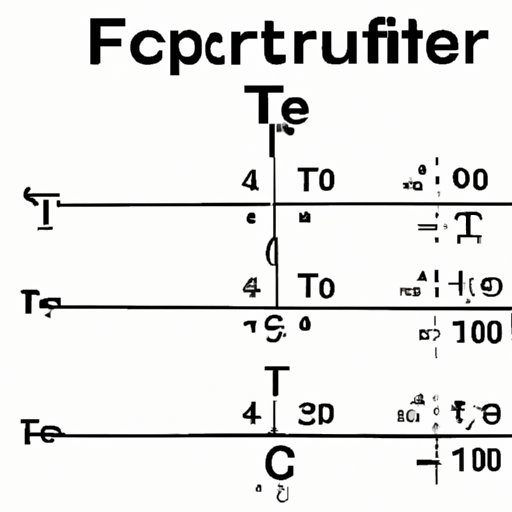
Introduction
As temperature is a universal metric, it is vital to know how to convert temperature measurements from one unit to another. Temperature conversion is easy once you have mastered the fundamentals and are familiar with the formulas and the techniques. In this article, you will learn how to convert Fahrenheit to Celsius, a useful skill particularly when traveling or living abroad. Read on to learn some simple steps to convert Fahrenheit to Celsius.
Break Down the Conversion Formula
To convert Fahrenheit to Celsius, we use the following formula:
C = (F – 32) * 5/9
In this formula, C represents the Celsius temperature, and F is the Fahrenheit temperature. So if we have a Fahrenheit temperature, let’s say 86°F, the steps to convert it to Celsius are as follows:
1. Subtract 32 from the Fahrenheit temperature: 86°F – 32 = 54°F
2. Multiply the result by 5/9: 54°F * 5/9 = 30°C.
Therefore, 86°F is equal to 30°C.
Use a Conversion Chart
Some people might find using a chart easier when converting temperatures rather than memorizing the formula. Here is a conversion chart showing Fahrenheit and Celsius temperatures side by side:
| Fahrenheit | Celsius |
|---|---|
| 32°F | 0°C |
| 50°F | 10°C |
| 68°F | 20°C |
| 86°F | 30°C |
| 104°F | 40°C |
To use the chart, find the Fahrenheit temperature in the left column, and follow it across to the right to find the Celsius temperature.
Explain why it’s important to know how to convert Fahrenheit to Celsius
Understanding how to convert between Fahrenheit and Celsius is an essential skill in many professions and for everyday use. It is beneficial when traveling to other countries, cooking, and weather forecasting, among others.
For example, most countries in the world use the Celsius system for temperature measurement. If you’re traveling to a foreign country and the temperature is listed in Celsius, you must know how to convert it to Fahrenheit to make sense of the temperature measurement.
Provide Real-World Examples
Converting temperature measurements is essential in various everyday situations. Here are some real-world examples:
1. Cooking
Many cooking recipes use Celsius to indicate cooking temperatures. For example, if the recipe calls for preheating the oven to 180°C and you only have a Fahrenheit oven, you need to know how to convert the temperature. So, using the conversion formula, we can convert 180°C into Fahrenheit:
F = (C * 9/5) + 32
F = (180 * 9/5) + 32
F = 356°F
The oven should be preheated to 356°F.
2. Weather Forecasting
Most weather forecasts use Celsius to indicate temperatures. So, if you want to know the temperature in Fahrenheit, you need to know the conversion. For instance, if the forecast predicts a high of 26°C, it is equal to:
C = (F – 32) * 5/9
F = (C * 9/5) + 32
F = (26 * 9/5) + 32
F = 78.8°F
The high temperature for the day is 78.8°F.
Explain the Differences Between the Two Units of Measurement
Fahrenheit and Celsius are two different units of measuring temperature. Fahrenheit is a temperature scale where water freezes at 32°F and boils at 212°F. Celsius, also known as centigrade, is a temperature scale where water freezes at 0°C and boils at 100°C.
The Celsius scale is more common worldwide, as most countries, except the United States, Liberia, and Myanmar, use Celsius to measure temperatures. However, in the United States, Fahrenheit is the primary unit used to measure temperature, and people may use it in day-to-day life, such as describing the weather or setting the oven temperature.
Make it Visual
For visual learners, creating an infographic or video that explains Fahrenheit to Celsius conversion can be more helpful than written instructions. Infographics and videos are more engaging, easier to remember, and easier to understand. An infographic, chart, or video can provide a quick reference guide that you can hang on your wall or save on your phone for future reference.
Conclusion
Knowing how to convert Fahrenheit to Celsius is an essential skill that is useful in many areas of life. We have outlined the formula, the use of conversion charts, the importance of this skill, real-world examples, the differences between the two units, and how to make it visual. By following these simple steps, you can master temperature conversion and use it in various situations, whether you’re cooking, traveling, or reading the weather forecast. Always remember, if you don’t use it, you lose it, so make time to practice your new skill.





